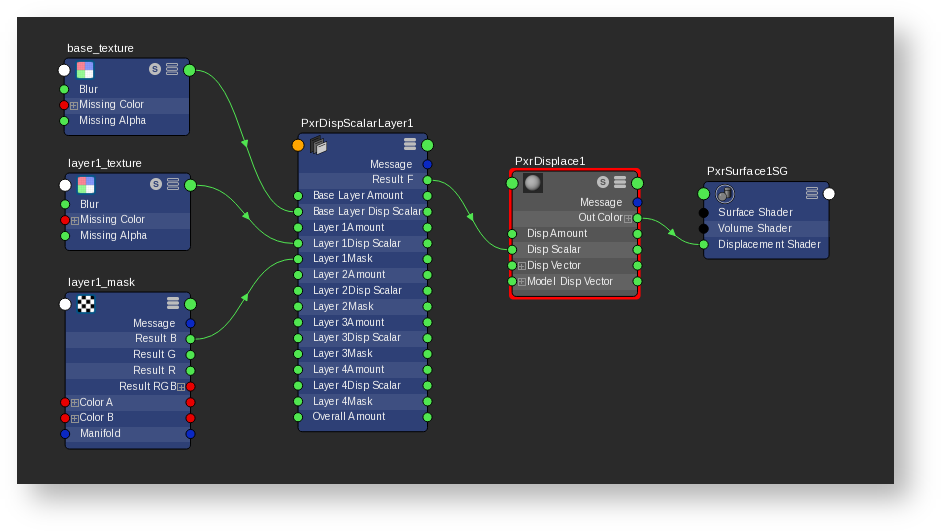Contents
This pattern layers the input scalar displacement patterns.
Each PxrDispScalarLayer supports up to 5 layers.
If you need more than 5 layers, connect the result of one PxrDispScalarLayer node to the input of another PxrDispScalarLayer node.
We need to connect the result of this pattern to the input of PxrDisplace's Scalar Displacement in order to displace the geometry.
Input Parameters
Overall Gain
Controls the gain of the final layered scalar displacement result. This is handy when we want to globally adjust the amount of all layered displacement values. Each layer's gain is being multiplied by this parameter.
Base Layer
Enabled
By default, the base layer is enabled. But say we need to debug, we can disable the base by unchecking this parameter. It if is unchecked, the base layer will be skipped for layering.
Base Layer Gain
Gain for the base layer.
Base Layer Scalar
Connection to the scalar displacement pattern. It can be any pattern's output float result such as resultF, resultR, resultG, resultB.
Layer1
Enabled
If checked, layer 1 is enabled.
Layer 1 Gain
Gain for the layer 1.
Layer 1 Scalar
Connection to the scalar displacement. It can be any pattern's output float result such as resultF, resultR, resultG, resultB.
Layer 1 Mask
Mask for this layer 1. Value that is closer to zero will apply less of this layer.
Layer 1 Operation
Choose how this layer's displacement combines with the base layer.
- 1: Add - adds layer 1 to the base layer.
- 2: Over - composites layer 1 on top of the base layer.
- 3: Multiply - multiplies layer 1 with the base layer.
- 4: Average - returns the average between layer 1 and the base layer.
- 5: Min - returns the minimum between layer 1 and the base layer.
- 6: Max - returns the maximum between layer 1 and the base layer.
Layer2
Enabled
If checked, layer 2 is enabled.
Layer 2 Gain
Gain for the layer 2.
Layer 2 Scalar
Connection to the scalar displacement. It can be any pattern's output float result such as resultF, resultR, resultG, resultB.
Layer 2 Mask
Mask for this layer 2. Value that is closer to zero will apply less of this layer.
Layer 2 Operation
Choose how this layer's displacement combines with the previous layer. If the layer 1 is not enabled, it will combine with the result of the base layer.
- 1: Add - adds layer 2 to layer 1.
- 2: Over - composites layer 2 on top of layer 1.
- 3: Multiply - multiplies layer 2 with layer 1.
- 4: Average - returns the average between layer 2 and layer 1.
- 5: Min - returns the minimum between layer 2 and layer 1.
- 6: Max - returns the maximum between layer 2 and layer 1.
Layer 3 to 4
Similar parameters to Layer 2.
Output Parameters
resultF
The float output.

